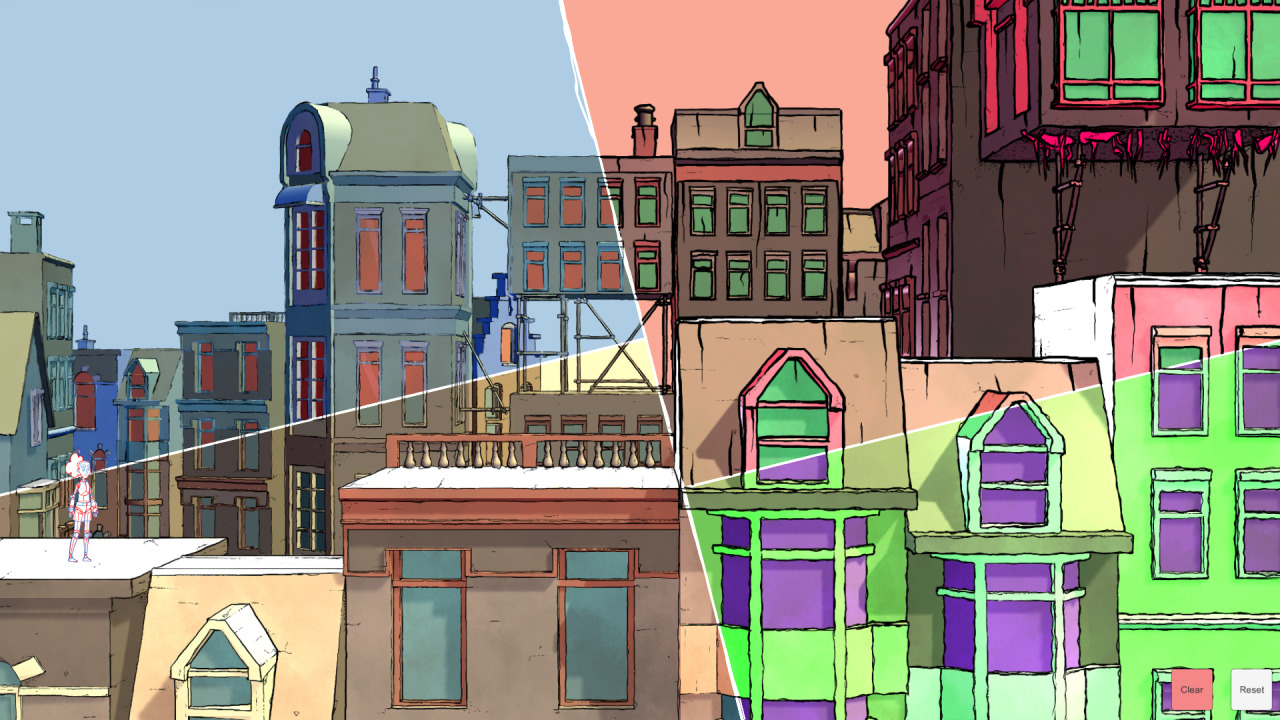
Featured Blog | This community-written post highlights the best of what the game industry has to offer. Read more like it on the Game Developer Blogs or learn how to Submit Your Own Blog Post
Fear and Change. How Making The Hard Decision Saved Rosvita
Making games can take a hard toll on the ego. As creators we understandly get attached to our favourite mechanics, the things that make our project unique and interesting. But what happens when those mechanics have a detrimental effect on the project?

What Was Rosvita?:
When we started Rosvita we had a clear idea for a brain twisting little mobile puzzle game with a leisurely pace and a unique puzzle mechanic.
As is the habit of a wide-eyed inexperienced indie developer I also wanted it to have an engaging narrative, a deep world for players to explore and discover, a unique art style and a complex layered set of mechanics which would allow players solve a puzzle anyway they choose! Needless to say this lead to confusion, indecision and division within the team as development trundled along.
The original design for the game was in the style of The Incredible Machine or The Amazing Alex. You had no control over Rosvita directly, instead you sliced up the screen to create segments of varying alternate realities, hit the play button and watched Rosvita automatically run through your reality warping Rube Goldberg machine to success or failure at the far end.

(the old line slicing mechanic in action)
Why Change?
1: Overloading the Player
Whilst the line slicing was unique, It very quickly became convoluted for the player to adequately place and manipulate lines in order to solve puzzles. Slicing the screen was fine but with a puzzle the first solution rarely works. As such we needed authoring tools which let the player relocate, delete, resize and reorient lines. More than this they also had to chose the priority of the lines, whether they intersected others or were intersected by them, should lines cut through eachother when you placed them or not? If so how do we manage the mess created when the placement of a single line creates 5 new assets for the player and the game to manage!?
It also produced a problem with how the player approached the process of finding a solution, it was too open-ended:
Have you ever been to a shop to buy a snack, a game or something only to find yourself overwhelmed by the amount of choice you have? You are paralysed with indecision as your brain tries to calculated the optimal strategy to satisfy your munchies or alleviate your boredom.
The same can be true of gameplay. Rosvita’s slicing mechanic was too granular, it allowed for a ton of scope in solving puzzles, too much in fact. When solving a puzzle the player was presented with a blank canvas and told to go at it, this is a recipe for frustration. Good puzzle design allows the player to express their own intelligence and ingenuity by providing the tools to facilitate and guide them. Obfuscation is not good puzzle design!
2: Overloading the Developer
There was also a whole heap for us as developers to manage. The slicing mechanic looked simple enough but the tech running it was surprising complex. Whenever a new intersection was made it took a difficult set of calculations to produce the ensuing mesh but adding the need to freely reposition and reorient lines meant the problem grew exponentially.
There was also the issue of level design, it wasn't enough to design a compelling puzzle we also had to work out a pipeline to facilitate the automated movement of Rosvita. We considered AI behavious to solve the problem but this had too many edge cases to cater for and was prone to regular errors.
Instead we opted for triggers placed throughout the level to prompt various movements and jumps at the right time.

(an example of the triggers we were using to facilitate this automated movement.)
This was better but far from fool-proof. The triggers still resulted in many instances of the player getting stuck or the character moving in erratic ways. It also became a full time job testing and tweaking the triggers endlessly to find equilibrium and this often bled into changing the movement system itself in the hopes that it would force the experience to click (more on this shortly.) Truth be told we were fighting fires rather than developing a game.
3: It Just Wasn't Very Good.
As the development process went on every change we made did nothing to make the game fun, they often made it worse.
We kept up a frantic pace of tweaking and manipulating the game trying any number of ad hoc fixes in an effort to cause a domino effect where everything would click into place. In essence we were trying to hammer a square peg into a round hole, all the while politely ignoring how fruitless a task this was.
4: Uniqueness Isn't Always Good.
This reason was an important and difficult lesson for me personally. The changes we eventually made bring the game in line with other titles, our colleagues and competitors.
This took a great deal of effort on my part to come to terms with. As creators we want our game to be unique, it’s only natural. We want to break new ground, we want to explore new ideas, we want to stand out! But uniqueness for uniqueness’ sake can be toxic to creativity. If your clever unique aspect is compromising the whole project then you have to be brutally honest about its inclusion.
In Rosvita the slicing was problematically unique. We had nothing to go off with it's implementation so we were flying blind. Perhaps it could work in the aforementioned mobile game but for the experience we’re creating we need something instantly familiar for the player to latch onto but also something more wieldy for us as developers.
There is no shame in this. By removing one unique thing we are able to bolster other unique aspects of our game by offering a sort of scaffolding of tried and tested mechanics on which our more nuanced mechanics can hang.
This mirrors our desired experience for the players. I stated before that being presented with a blank canvas obfuscates the puzzle for the player and will frustrate them as they stab blindly into the dark. By trying to apply our intelligence and creativity to a more structured setting we are able to make the game so much more than it would be otherwise.
5: The Platform Was Wrong For The Experience.
Between the difficulty of implementation the development malaise surrounding the project and my personal uncertainty new considerations came to light:
We had to think about the type of experience we wanted the player to have. We want them to engage with a deep story, connect with the character and revel in their exploration and discovery of a meticulously rendered fantastic world. A fire and forget mobile game would not suit these aims as they divorce the player from this kind of connection.
We were already dimly aware of these considerations. While we were trying to make all the disperate mechanics work together we tried numerous configurations of player interaction.
We tried having the player control the character completely but this caused friction in their experience as they had to switch from movement to slicing because the two mechanics did not work seemlessly with each other. This caused fiction, slowed the pace of the game and frustrated the player as they felt hamstrung.
We tried various configurations of the automated movement but this caused a disconnect between the player, the world and Rosvita. Instead of playing as a young girl on an odyssey you played as some disembodied spirit manipulating a maze for a dumb animal to run through.
In the height of desperation we tried a marriage of the two, the player held down a button to move Rosvita but she could only move in one direction unless triggered otherwise. This was neither one thing or the other and really inhereted the problems from both.
We had to have a hard think about what we really wanted to say and do with Rosvita, what we wanted players to walk away from thinking, feeling and hopefully talking about after a satisfying experience.
This shifted our target platform. The experience we were trying to sell wasn't a good fit with the mechanics we had and they were fighting with each other, also mobile gaming has become an incredibly toxic environment to release your first game, especially one which would require as large an investment of our time and effort as Rosvita. So now we are focusing our efforts to PC and then console. From what we have discussed with other devs and industry professionals these markets are less saturated (though far from virgin grounds) and a lot more forgiving for first time developers.
Making the Big Change
A clear lesson we learned from this painful process was this; If no amount of adjustments fixes the problem, you have a fundamental issue which you must address first.
If we couldn’t marry our slice mechanic with what we wanted to achieve in the game experience the slicing mechanic had to go!
I talk about the emotional process of this change in the video below:
With the slicing mechanic gone In it’s place we have a reality changing system that is more rooted in Rosvita herself. Before we had disembodied slicing, now we have a projectile fired by the player that creates an area of effect when detonated.
Whilst this gives the player far less versatility it does ground them in the world. In turn the restricted control offers them a lot more clarity in solving puzzles.
With the focus now placed squarely back on Rosvita it feels more natural to have direct control over her movements. There are no longer two competing mechanics vying for the player’s attention and so the overall experience is finally cohesive.
Conclusion and Moving Forward:
These decisions are hard to make. They come with a whole host of baggage with them, does it compromise your vision? Are you doing more harm than good? What if it still doesn't work?
For us it was all these things and a serious time constraint. We're out in the Swedish Wilderness at Stugan the game's accelerator set up by Tommy Palm, Oskar Burman and a whole host of generous supporters. This quandry struck right in the middle of our time here and we had to ask if it was wise for us to make such a huge shift in direction at such a late stage. Would this be letting our mentors and ourselves down?
In the end we had to make the change, finishing Stugan with a game we had no faith in would have been a greater tradgedy than any other so we pressed forward and we're glad we did.
Up to this point I had grown dispassionate and disconnected about the project but as soon as I sat down after the decision was made with worry in my heart and a sketchbook in my hand, ideas just poured out of me in a torrent. My creative spark was revitalised and Rosvita sprang back into life again. The game is better now than it has ever bveen at the problems we are facing going forwards are far more surmountable and less existential in scope.
Read more about:
Featured BlogsAbout the Author(s)
You May Also Like







.jpeg?width=700&auto=webp&quality=80&disable=upscale)








